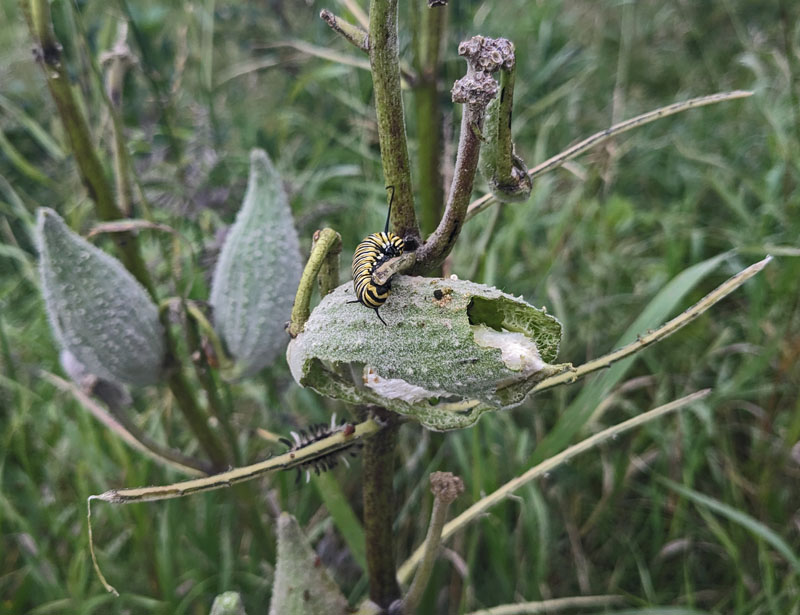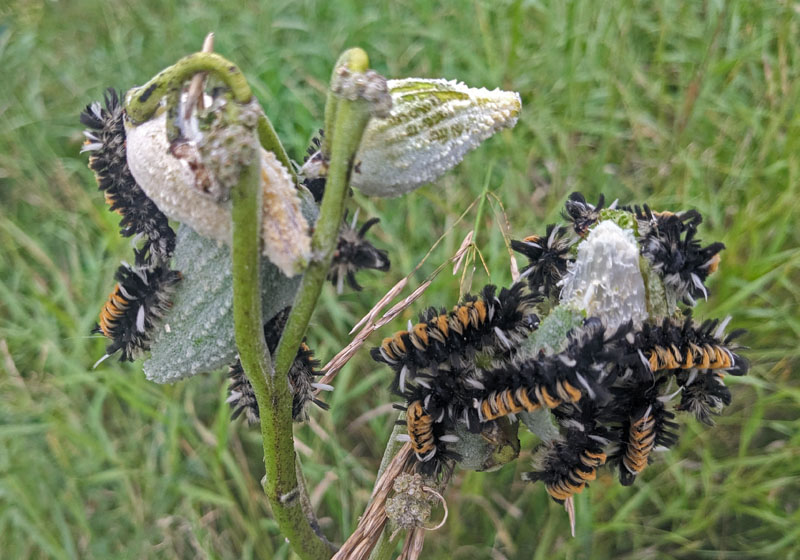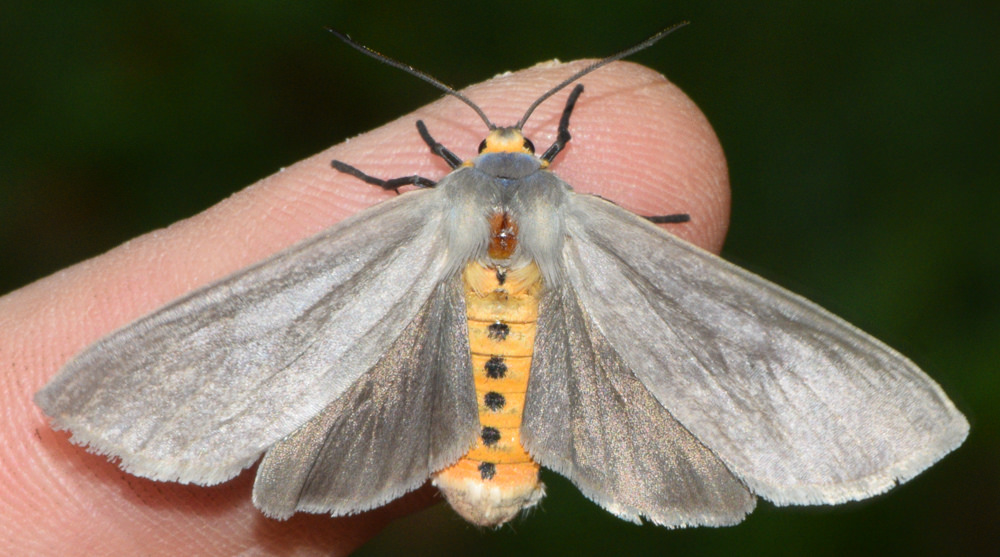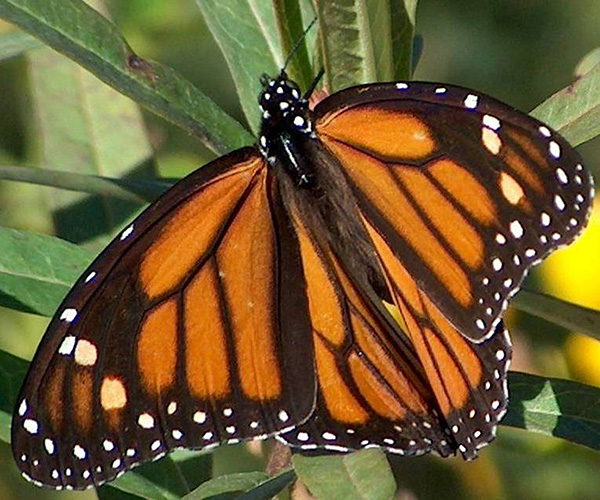The natural world never ceases to fascinate me. The more I see, and learn, the more amazing I find the intricate interplay between plants and animals. Today I learned something about mimicry.
My last post was about toxic toads. On this morning’s run with Conall I saw two other toxic animals: monarch butterfly and milkweed tussock moth caterpillars, all snacking companionably on a milkweed plant.
They’re gorgeous. Brightly colored. Eye-catching.
The monarch butterfly caterpillar is smooth, with filaments that look like antennae on both ends. Its entire body is striped with bands of yellow, white, and black.

The milkweed tussock moth caterpillar has alternating bands of short orange and black fuzz, with longer tufts of white and black fuzz along its sides. It resembles a colorful bottle cleaning brush.

The reason I noticed the caterpillars during my run was that the moth caterpillars were in a large group – called an army – feeding on the light green and white milkweed seed pods at hip level, right next to the road. Hard to ignore.
Milkweed leaves are the only food source for monarch caterpillars. Why?
Milkweed contains a variety of chemical compounds that make monarch caterpillars poisonous to potential predators. Milkweeds contain a cardiac (heart) poison that is poisonous to most vertebrates (animals with backbones) but does not hurt the monarch caterpillar.
USDA.
That poison supplied by the milkweed leaves—cardenolides, or cardiac glycosides—is the monarch’s defense against predation from birds and others (e.g., spiders, fire ants, wasps), both as a caterpillar (larvae) and a butterfly. Most birds will spit them out or throw up, learning avoid them by recognizing the bright “warning” coloration.
The milkweed tussock moth caterpillar has similar coloration, is about the same size (taking into account the fuzz), and feeds on the same plant, also storing the milkweed’s cardiac glycoside toxins. This is called Müllerian mimicry, where two or more insects with the same toxic chemicals display similar color patterns to warn off predators. The theory is that the mimicry simplifies the number of colors predators need to learn to avoid.
Milkweed tussock moth caterpillars are social, often feeding together. They can afford to. One caterpillar eaten and a bird will quickly throw up (just like Conall after eating the toxic toad), moving on to find more wholesome food. The adult moths are nocturnal; the toxins stored in their bodies deter predation by bats.

In the past, digitalis and digoxin were cardiac glycoside drugs used for congestive heart failure in humans. Nausea was a warning that the drug levels were too high.
Milkweed tussock moth caterpillars aren’t the only species to mimic the monarch.
The Viceroy butterfly takes advantage of the protective coloration of the monarch butterfly by “mimicking,” or copying the colors and pattern of the monarch wing. With similar coloration, the viceroy can be mistaken for a monarch and is safe from these “educated” predators.
USDA


Knowing I’d find good photos and information about caterpillars, I visited blogger friend Kim Smith’s website, Nature is My Therapy. Kim didn’t disappoint. Her August 9th post is about milkweed flowers in her native plants garden and the insects that enjoy them, and an older post from 2018 is about tussock moth caterpillars. Her photos and videos are terrific. Visit and look around her site.
So far this year, I’ve seen just one monarch butterfly. That was this spring, likely on its northward migration. Lately I’ve been looking for monarch caterpillars on milkweed leaves, and today’s was the first and only I’ve spotted, thanks to the tussock moth caterpillars. I’ll keep looking, hoping to see more monarch caterpillars as well as butterflies heading to their winter habitat. Monarchs aren’t thriving; they need more milkweed to survive. Please plant milkweed in your gardens, but make sure it’s the right type:
There are a several native and introduced milkweed plants in the genus Cynanchum (swallow-worts) that are also eaten by monarchs. Swallow-worts have similar chemical properties to milkweeds in the genus Asclepias, that fool monarchs into laying eggs on them. Cynanchum species are not suitable food for monarch larvae. Caterpillars fail to develop into pupae when feeding on them. Please do not plant these milkweeds in your garden.
USDA
***
Feature photo: Milkweed plant and flowers, growing in the neighbors’ fields where the boys and I regularly get to run and walk. Photo taken July 4, 2022, with a bonus dog photobomb.


Nice post, Rebecca, and thanks for the links to my blog. I love finding those tussock moth armies!
LikeLiked by 2 people
Thanks, Kim! I hope you’ll see a bunch new subscribers to your blog 🙂
LikeLiked by 1 person
Milkweed is everywhere in “my” wetlands. Some years I get to see butterflies. Since this summer is the hot bitch from hell and the deer flies (which are usually gone by now) are still hanging around, I haven’t had the chance for a leisurely ramble through the wetlands. I didn’t know about the Viceroy Butterfly. That’s very cool! Maybe it will cool down before the season is spent. I hope so. Thanks for the link to Kim Smith’s blog.
LikeLiked by 1 person
You really are burdened with a hot, dry summer; so sorry. Wish I could send some of Vermont’s (excessive) summer rain your way. Maybe you’ll get to see some monarchs during cooler September. I’m hoping a spot a few here.
You’ll enjoy Kim’s blog. She makes insects interesting and fun!
LikeLiked by 1 person
Between us (do not tell the deer flies) I’m interested in insects. It’s all just this cool wondrous surprising and sometimes painful adventure out there in a world I never met before. Wetlands have a complexity that I will probably never finish exploring. Stuff wants to live there. Seeing the tiger salamander was the best — it’s the only salamander in Colorado.
LikeLike
I’ve read that some butterfly populations have been decreasing. In my area (greater Philadelphia), I’ve seen very few butterflies this year.
LikeLiked by 1 person
Sorry to be slow to respond, I just saw this. I’ve had the same experience – few butterflies of any kind. I counted a whopping total of seven Monarchs this fall (and I couldn’t have counted one more than once), no Swallowtails. So strange. Makes me more determined to convert lawn to pollinator garden.
LikeLike
I hope you see more Monarchs next year. We planted some milkweed, but no Monarchs yet. 🤞 The tussock moth caterpillars remind me of what we called “wooly bears” in Seattle.
LikeLiked by 1 person